Hyperbola(双曲线)
发现了一个网站,里面讲的还不错,转载过来,复习知识的时候,再看看原滋原味的英文,舒服。
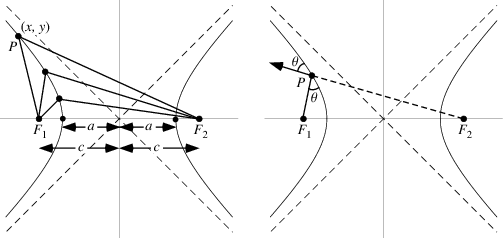
A hyperbola (plural "hyperbolas"; Gray 1997, p. 45) is a conic section defined as the locus of all points ![]() in the plane the difference of whose distances
in the plane the difference of whose distances ![]() and
and ![]() from two fixed points (the foci
from two fixed points (the foci ![]() and
and ![]() ) separated by a distance
) separated by a distance ![]() is a given positive constant
is a given positive constant ![]() ,
,
| (1) |
(Hilbert and Cohn-Vossen 1999, p. 3). Letting ![]() fall on the left
fall on the left ![]() -intercept requires that
-intercept requires that
| (2) |
so the constant is given by ![]() , i.e., the distance between the
, i.e., the distance between the ![]() -intercepts (left figure above). The hyperbola has the important property that a ray originating at a focus
-intercepts (left figure above). The hyperbola has the important property that a ray originating at a focus ![]() reflects in such a way that the outgoing path lies along the line from the other focus through the point of intersection (right figure above).
reflects in such a way that the outgoing path lies along the line from the other focus through the point of intersection (right figure above).
The special case of the rectangular hyperbola, corresponding to a hyperbola with eccentricity ![]() , was first studied by Menaechmus. Euclid and Aristaeus wrote about the general hyperbola, but only studied one branch of it. The hyperbola was given its present name by Apollonius, who was the first to study both branches. The focus and conic section directrix were considered by Pappus (MacTutor Archive). The hyperbola is the shape of an orbit of a body on an escape trajectory (i.e., a body with positive energy), such as some comets, about a fixed mass, such as the sun.
, was first studied by Menaechmus. Euclid and Aristaeus wrote about the general hyperbola, but only studied one branch of it. The hyperbola was given its present name by Apollonius, who was the first to study both branches. The focus and conic section directrix were considered by Pappus (MacTutor Archive). The hyperbola is the shape of an orbit of a body on an escape trajectory (i.e., a body with positive energy), such as some comets, about a fixed mass, such as the sun.
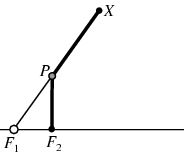 |
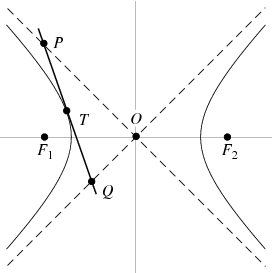 |
The hyperbola can be constructed by connecting the free end ![]() of a rigid bar
of a rigid bar ![]() , where
, where ![]() is a focus, and the other focus
is a focus, and the other focus ![]() with a string
with a string ![]() . As the bar
. As the bar ![]() is rotated about
is rotated about ![]() and
and ![]() is kept taut against the bar (i.e., lies on the bar), the locus of
is kept taut against the bar (i.e., lies on the bar), the locus of ![]() is one branch of a hyperbola (left figure above; Wells 1991). A theorem of Apollonius states that for a line segment tangent to the hyperbola at a point
is one branch of a hyperbola (left figure above; Wells 1991). A theorem of Apollonius states that for a line segment tangent to the hyperbola at a point ![]() and intersecting the asymptotes at points
and intersecting the asymptotes at points ![]() and
and ![]() , then
, then ![]() is constant, and
is constant, and ![]() (right figure above; Wells 1991).
(right figure above; Wells 1991).
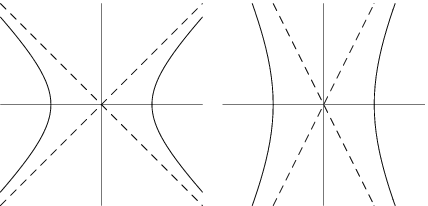
Let the point ![]() on the hyperbola have Cartesian coordinates
on the hyperbola have Cartesian coordinates ![]() , then the definition of the hyperbola
, then the definition of the hyperbola ![]() gives
gives
| (3) |
Rearranging and completing the square gives
| (4) |
and dividing both sides by ![]() results in
results in
| (5) |
By analogy with the definition of the ellipse, define
| (6) |
so the equation for a hyperbola with semimajor axis ![]() parallel to the x-axis and semiminor axis
parallel to the x-axis and semiminor axis ![]() parallel to the y-axis is given by
parallel to the y-axis is given by
| (7) |
or, for a center at the point ![]() instead of
instead of ![]() ,
,
| (8) |
Unlike the ellipse, no points of the hyperbola actually lie on the semiminor axis, but rather the ratio ![]() determines the vertical scaling of the hyperbola. The eccentricity
determines the vertical scaling of the hyperbola. The eccentricity ![]() of the hyperbola (which always satisfies
of the hyperbola (which always satisfies ![]() ) is then defined as
) is then defined as
 |
(9) |
In the standard equation of the hyperbola, the center is located at ![]() , the foci are at
, the foci are at ![]() , and the vertices are at
, and the vertices are at ![]() . The so-called asymptotes(shown as the dashed lines in the above figures) can be found by substituting 0 for the 1 on the right side of the general equation (8),
. The so-called asymptotes(shown as the dashed lines in the above figures) can be found by substituting 0 for the 1 on the right side of the general equation (8),
| (10) |
and therefore have slopes ![]() .
.
The special case ![]() (the left diagram above) is known as a rectangular hyperbola because the asymptotes are perpendicular.
(the left diagram above) is known as a rectangular hyperbola because the asymptotes are perpendicular.
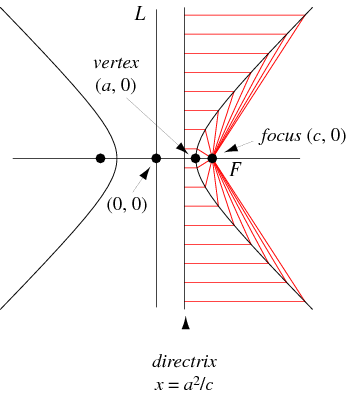
The hyperbola can also be defined as the locus of points whose distance from the focus ![]() is proportional to the horizontal distance from a vertical line
is proportional to the horizontal distance from a vertical line ![]() known as the conic section directrix, where the ratio is
known as the conic section directrix, where the ratio is ![]() . Letting
. Letting ![]() be the ratio and
be the ratio and ![]() the distance from the center at which the directrix lies, then
the distance from the center at which the directrix lies, then
| (11) |
|||
| (12) |
where ![]() is therefore simply the eccentricity
is therefore simply the eccentricity ![]() .
.
Like noncircular ellipses, hyperbolas have two distinct foci and two associated conic section directrices, each conic section directrix being perpendicular to the line joining the two foci (Eves 1965, p. 275).
The focal parameter of the hyperbola is
 |
(13) |
||
| (14) |
|||
| (15) |
In polar coordinates, the equation of a hyperbola centered at the origin (i.e., with ![]() ) is
) is
| (16) |
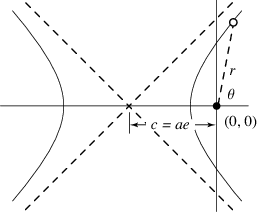
In polar coordinates centered at a focus,
| (17) |
as illustrated above.
The two-center bipolar coordinates equation with origin at a focus is
| (18) |
Parametric equations for the right branch of a hyperbola are given by
| (19) |
|||
| (20) |
where ![]() is the hyperbolic cosine and
is the hyperbolic cosine and ![]() is the hyperbolic sine, which ranges over the right branch of the hyperbola.
is the hyperbolic sine, which ranges over the right branch of the hyperbola.
A parametric representation which ranges over both branches of the hyperbola is
| (21) |
|||
| (22) |
with ![]() and discontinuities at
and discontinuities at ![]() . The arc length, curvature, and tangential angle for the above parametrization are
. The arc length, curvature, and tangential angle for the above parametrization are
 |
(23) |
||
| (24) |
|||
| (25) |
where ![]() is an elliptic integral of the second kind.
is an elliptic integral of the second kind.
The special affine curvature of the hyperbola is
| (26) |
The locus of the apex of a variable cone containing an ellipse fixed in three-space is a hyperbola through the foci of the ellipse. In addition, the locus of the apex of a cone containing that hyperbola is the original ellipse. Furthermore, the eccentricities of the ellipse and hyperbola are reciprocals.
REFERENCES:
Beyer, W. H. CRC Standard Mathematical Tables, 28th ed. Boca Raton, FL: CRC Press, pp. 199-200 and 218, 1987.
Casey, J. "The Hyperbola." Ch. 7 in A Treatise on the Analytical Geometry of the Point, Line, Circle, and Conic Sections, Containing an Account of Its Most Recent Extensions, with Numerous Examples, 2nd ed., rev. enl. Dublin: Hodges, Figgis, & Co., pp. 250-284, 1893.
Courant, R. and Robbins, H. What Is Mathematics?: An Elementary Approach to Ideas and Methods, 2nd ed. Oxford, England: Oxford University Press, pp. 75-76, 1996.
Coxeter, H. S. M. "Conics" §8.4 in Introduction to Geometry, 2nd ed. New York: Wiley, pp. 115-119, 1969.
Eves, H. A Survey of Geometry, rev. ed. Boston, MA: Allyn & Bacon, 1965.
Fukagawa, H. and Pedoe, D. "The One Hyperbola." §5.2 in Japanese Temple Geometry Problems. Winnipeg, Manitoba, Canada: Charles Babbage Research Foundation, pp. 51 and 136-138, 1989.
Gardner, M. "Hyperbolas." Ch. 15 in Penrose Tiles and Trapdoor Ciphers... and the Return of Dr. Matrix, reissue ed. New York: W. H. Freeman, pp. 205-218, 1989.
Gray, A. Modern Differential Geometry of Curves and Surfaces with Mathematica, 2nd ed. Boca Raton, FL: CRC Press, 1997.
Hilbert, D. and Cohn-Vossen, S. Geometry and the Imagination. New York: Chelsea, pp. 3-4, 1999.
Lawrence, J. D. A Catalog of Special Plane Curves. New York: Dover, pp. 79-82, 1972.
Lockwood, E. H. "The Hyperbola." Ch. 3 in A Book of Curves. Cambridge, England: Cambridge University Press, pp. 24-33, 1967.
Loomis, E. S. "The Hyperbola." §2.3 in The Pythagorean Proposition: Its Demonstrations Analyzed and Classified and Bibliography of Sources for Data of the Four Kinds of "Proofs," 2nd ed. Reston, VA: National Council of Teachers of Mathematics, pp. 22-23, 1968.
MacTutor History of Mathematics Archive. "Hyperbola." http://www-groups.dcs.st-and.ac.uk/~history/Curves/Hyperbola.html.
Wells, D. The Penguin Dictionary of Curious and Interesting Geometry. London: Penguin, pp. 106-109, 1991.
Yates, R. C. "Conics." A Handbook on Curves and Their Properties. Ann Arbor, MI: J. W. Edwards, pp. 36-56, 1952.
http://mathworld.wolfram.com/Hyperbola.html
文章来源: reborn.blog.csdn.net,作者:李锐博恩,版权归原作者所有,如需转载,请联系作者。
原文链接:reborn.blog.csdn.net/article/details/83687923
- 点赞
- 收藏
- 关注作者


评论(0)